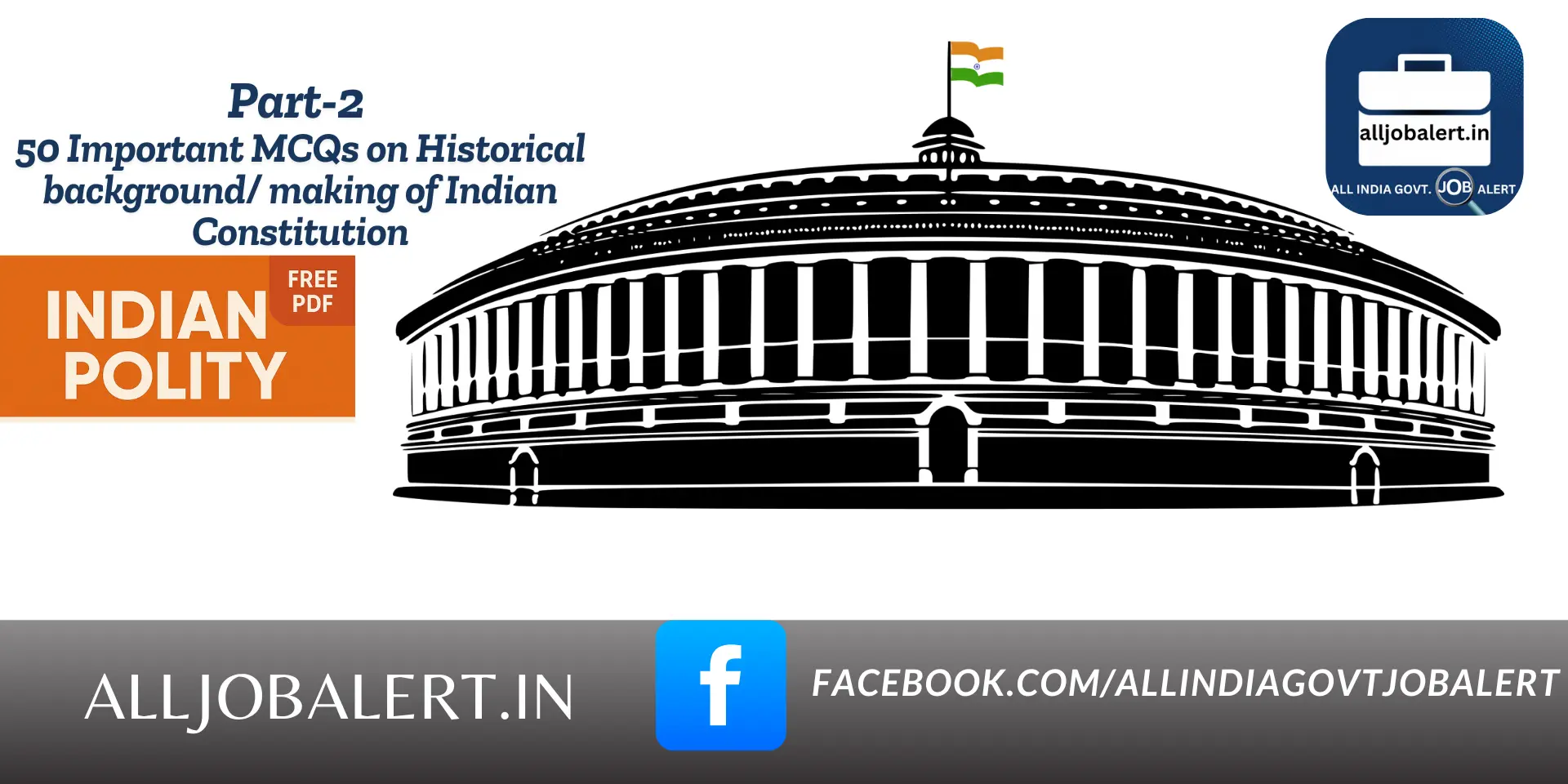
Indian Polity MCQ plays a crucial role in almost every government competitive exam. Among the key topics, the historical background of Indian Constitution and the Preamble of Indian Constitution (also referred to as the Preamble of India) are frequently asked. In this post, we have compiled another 50 important questions (Part-2) in a free Indian Polity MCQ with Answers PDF, focusing on these core areas. These MCQs, covering the formation of the Constitution and its guiding principles, have been repeatedly asked in various central and state-level exams. You can easily download or save the Indian Polity PDF for future reference and even share it with your friends and study partners to strengthen your exam preparation.
MCQ Questions on Historical Background of the Making of the Constitution of India– Indian Polity MCQ
- When the Constituent Assembly of India was first convened?
a) December 9, 1946
b) August 15, 1947
c) January 26, 1950
d) November 26, 1949 - Who was the President of the Constituent Assembly of India?
a) Dr. B.R. Ambedkar
b) Dr. Rajendra Prasad
c) Jawaharlal Nehru
d) Sardar Vallabhbhai Patel - The idea of a Constituent Assembly for India was first proposed by:
a) Jawaharlal Nehru
b) M.N. Roy
c) Mahatma Gandhi
d) B.R. Ambedkar - The Government of India Act, 1935, was a significant influence on the Indian Constitution. It introduced:
a) Complete independence
b) Provincial autonomy
c) Universal adult franchise
d) A unitary state - The Cabinet Mission Plan was introduced in which year?
a) 1942
b) 1945
c) 1946
d) 1947 - The Objective Resolution, which laid down the philosophy of the Indian Constitution, was moved by:
a) Dr. B.R. Ambedkar
b) Jawaharlal Nehru
c) Sardar Patel
d) Maulana Abul Kalam Azad - The Indian Independence Act was passed by the British Parliament in:
a) 1945
b) 1946
c) 1947
d) 1948 - The Constituent Assembly adopted the Constitution of India on:
a) January 26, 1950
b) November 26, 1949
c) August 15, 1947
d) December 9, 1946 - How many members were initially part of the Constituent Assembly?
a) 299
b) 389
c) 308
d) 405 - The Drafting Committee of the Constitution was chaired by:
a) Dr. Rajendra Prasad
b) Dr. B.R. Ambedkar
c) Jawaharlal Nehru
d) Alladi Krishnaswamy Ayyar - The concept of Fundamental Rights in the Indian Constitution was inspired by:
a) The British Constitution
b) The U.S. Constitution
c) The French Constitution
d) The Soviet Constitution - Which act provided for the establishment of a Constituent Assembly for India?
a) Government of India Act, 1919
b) Government of India Act, 1935
c) Indian Independence Act, 1947
d) Cripps Mission, 1942 - The Mountbatten Plan, which led to the partition of India, was announced in:
a) June 1947
b) August 1947
c) March 1947
d) May 1946 - The first session of the Constituent Assembly was held in:
a) Bombay
b) Calcutta
c) New Delhi
d) Lahore - The idea of a federal structure for India was borrowed from which country’s constitution?
a) United States
b) Canada
c) United Kingdom
d) Ireland - The Constituent Assembly took how long to frame the Constitution?
a) 1 year, 11 months
b) 2 years, 11 months
c) 3 years, 11 months
d) 4 years, 11 months - Who was the constitutional advisor to the Constituent Assembly?
a) B.N. Rau
b) K.M. Munshi
c) Alladi Krishnaswamy Ayyar
d) N. Gopalaswami Ayyangar - The demand for a Constituent Assembly was first made by the Indian National Congress in:
a) 1924
b) 1934
c) 1940
d) 1946 - The Preamble of the Indian Constitution was inspired by the Preamble of which country’s constitution?
a) United States
b) Ireland
c) Canada
d) Australia - Which of the following was NOT a feature borrowed from the Government of India Act, 1935?
a) Federal structure
b) Governor-General’s powers
c) Fundamental Rights
d) Bicameral legislature - The Cripps Mission, which proposed a framework for the Indian Constitution, was sent in:
a) 1940
b) 1942
c) 1944
d) 1946 - The Constituent Assembly was composed of members elected by:
a) Direct elections
b) Provincial legislatures
c) British Parliament
d) Princely states only - The Muslim League initially boycotted the Constituent Assembly but joined after:
a) The Cabinet Mission Plan
b) The Mountbatten Plan
c) The Indian Independence Act
d) The Objective Resolution - The concept of Directive Principles of State Policy was borrowed from which country’s constitution?
a) Ireland
b) United States
c) United Kingdom
d) Canada - The total number of sessions held by the Constituent Assembly was:
a) 9
b) 11
c) 13
d) 15 - The Indian Constitution was enacted and adopted on:
a) January 26, 1950
b) November 26, 1949
c) August 15, 1947
d) December 9, 1946 - Which committee recommended the inclusion of Fundamental Duties in the Constitution?
a) Swaran Singh Committee
b) Balwant Rai Mehta Committee
c) Ashok Mehta Committee
d) Sarkaria Commission - The Indian Constitution is often described as:
a) Rigid
b) Flexible
c) Partly rigid and partly flexible
d) Unitary - The concept of a republic in the Indian Constitution was inspired by:
a) The French Constitution
b) The British Constitution
c) The U.S. Constitution
d) The Irish Constitution - The August Offer of 1940 was made by:
a) Lord Wavell
b) Lord Mountbatten
c) Lord Linlithgow
d) Lord Irwin - The number of articles in the Indian Constitution at the time of its adoption was:
a) 395
b) 385
c) 405
d) 415 - The Indian Constitution was influenced by the constitutional practices of which of the following countries?
a) Japan
b) Germany
c) Australia
d) All of the above - The Simon Commission, which influenced constitutional discussions, was appointed in:
a) 1927
b) 1930
c) 1935
d) 1942 - The principle of judicial review in the Indian Constitution was inspired by:
a) United Kingdom
b) United States
c) Canada
d) Ireland - The Constituent Assembly was indirectly elected through:
a) Universal adult franchise
b) Provincial assemblies
c) Nominated members
d) Direct public voting - The first draft of the Indian Constitution was presented in:
a) February 1948
b) November 1947
c) August 1947
d) January 1949 - The idea of a Constituent Assembly was formally accepted by the British government through:
a) Cripps Mission
b) Cabinet Mission
c) August Offer
d) Mountbatten Plan - The Indian Constitution came into full effect on:
a) August 15, 1947
b) November 26, 1949
c) January 26, 1950
d) December 9, 1946 - The Constituent Assembly was set up under the provisions of which plan?
a) Cripps Mission
b) Cabinet Mission
c) Mountbatten Plan
d) Wavell Plan - The concept of a secular state in the Indian Constitution was influenced by:
a) The U.S. Constitution
b) The French Constitution
c) The Soviet Constitution
d) The Irish Constitution - Who was the temporary chairman of the Constituent Assembly during its first meeting?
a) Sachchidananda Sinha
b) Dr. Rajendra Prasad
c) Dr. B.R. Ambedkar
d) Jawaharlal Nehru - The Indian Constitution borrowed the idea of emergency provisions from:
a) Weimar Constitution of Germany
b) U.S. Constitution
c) British Constitution
d) Canadian Constitution - The first meeting of the Constituent Assembly was boycotted by:
a) Indian National Congress
b) Muslim League
c) Princely States
d) Communist Party - The Government of India Act, 1935, was based on the recommendations of which commission?
a) Simon Commission
b) Nehru Report
c) Cripps Mission
d) Cabinet Mission - The Constituent Assembly’s deliberations were influenced by the:
a) Nehru Report of 1928
b) Simon Commission Report
c) Montague-Chelmsford Reforms
d) Rowlatt Act - The idea of a single citizenship in the Indian Constitution was borrowed from:
a) United States
b) United Kingdom
c) Canada
d) Ireland - The Constituent Assembly completed the drafting of the Constitution in:
a) 2 years, 11 months, and 18 days
b) 3 years, 11 months, and 18 days
c) 2 years, 10 months, and 18 days
d) 3 years, 10 months, and 18 days - The concept of Fundamental Duties was added to the Constitution later through which amendment?
a) 42nd Amendment
b) 44th Amendment
c) 24th Amendment
d) 39th Amendment - The Wavell Plan, which influenced the constitutional process, was proposed in:
a) 1942
b) 1943
c) 1944
d) 1945 - The Indian Constitution is known as one of the longest written constitutions in the world due to:
a) Its detailed provisions
b) Its rigid nature
c) Its brevity
d) Its unitary structure.
Correct Answers:
- a) December 9, 1946
- b) Dr. Rajendra Prasad
- b) M.N. Roy
- b) Provincial autonomy
- c) 1946
- b) Jawaharlal Nehru
- c) 1947
- b) November 26, 1949
- b) 389
- b) Dr. B.R. Ambedkar
- b) The U.S. Constitution
- c) Indian Independence Act, 1947
- a) June 1947
- c) New Delhi
- b) Canada
- b) 2 years, 11 months
- a) B.N. Rau
- b) 1934
- a) United States
- c) Fundamental Rights
- b) 1942
- b) Provincial legislatures
- c) The Indian Independence Act
- a) Ireland
- b) 11
- b) November 26, 1949
- a) Swaran Singh Committee
- c) Partly rigid and partly flexible
- a) The French Constitution
- c) Lord Linlithgow
- a) 395
- d) All of the above
- a) 1927
- b) United States
- b) Provincial assemblies
- a) February 1948
- b) Cabinet Mission
- c) January 26, 1950
- b) Cabinet Mission
- a) The U.S. Constitution
- a) Sachchidananda Sinha
- a) Weimar Constitution of Germany
- b) Muslim League
- a) Simon Commission
- a) Nehru Report of 1928
- b) United Kingdom
- a) 2 years, 11 months, and 18 days
- a) 42nd Amendment
- d) 1945
- a) Its detailed provisions
If you find this historical background of Indian Constitution MCQ post useful, then don’t forget to share it. For regular practice, you will find more Indian polity GK and other subject MCQs on our site. If you want the complete collection of Indian polity GK in PDF format, then you can tell us in the comments. Follow our blog to get more updates!
👉Get this in pdf. (Indian polity mcq with answers pdf)
Source: Internet, books, Wikipedia etc.
CONCLUSION
Please post comment, give feedback, your feed back is important to us. And also help us by sharing this post of Indian Polity GK. Very soon we will post the next part of Indian Polity GK. Thank you for visiting our post.
